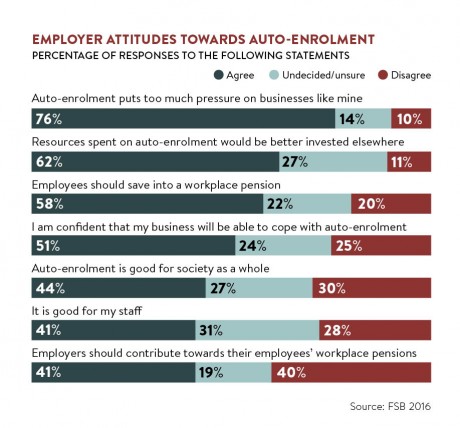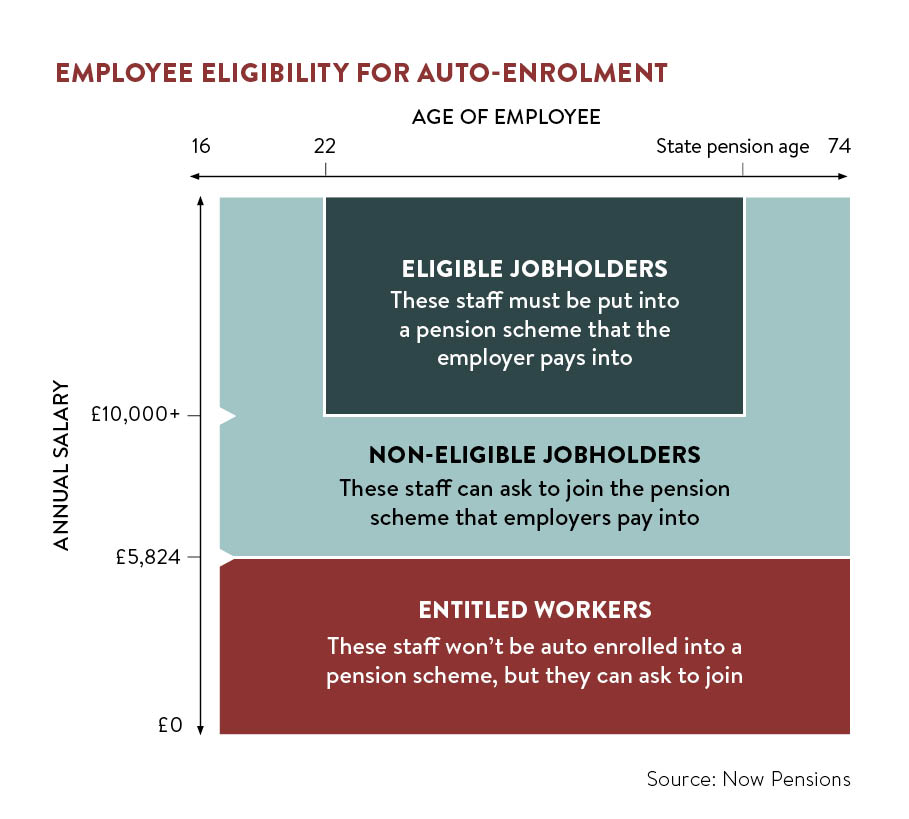By this time next year, the implementation of pension auto-enrolment will be complete. All employers, even individuals who only employ a nanny, must have started to enrol workers in a pension scheme.
In the three-and-a-half years since it launched, auto-enrolment has been something of a success. Data from the Pensions Regulator shows that as of March 2016 more than six million employees, who never had a pension scheme before, are now contributing to one.
Of course, this all comes at a cost. The employee has to make a contribution and so does the employer, who is also required to administer the whole process.
Offering added-value
Given that this is not a one-off compliance hit, but a process that must take place every time payroll is run, it would be easy for employers to see this as just another tax.
However, there are those who argue that employers should view auto-enrolment as a way for employers, even small firms, to use it as an opportunity to engage and motivate their staff.
“If an employer has to have it in place,” says Allan Maxwell, a director of Glasgow-based Corporate Benefits Consulting, “why not make the most of it and give it some value?” Employers could go the extra mile and provide a pension scheme which goes beyond the minimum requirements for auto-enrolment.

“The difference in costs between setting up a workplace scheme and setting up a high-quality scheme is very little,” says Mr Maxwell. “Offering one with more bells and whistles shows you care about the employees, but it is also more likely to be future proof and you will benefit from certain efficiencies.”
These efficiencies are definitely worth considering. Employers who implement a basic auto-enrolment scheme must split their workforce into three different categories – eligible jobholder who
must be enrolled, non-eligible jobholders who do not but have the right to opt in, and entitled workers who have a right to join.
Each of these groups is not only different, but must be treated, and communicated with, differently.
With a minimum contribution scheme, you must explain to employees how their contributions are calculated. This is difficult because it isn’t done on their whole earnings, but a portion of them and, as this is complex, you may end up explaining it many times.
In a business with seasonal work or variable pay where people may be coming on to the payroll or seeing their earnings qualify them for auto-enrolment, this can be an administrative nightmare. When the contribution rates change in 2018, you’ll have to do it all over again.
The benefits of investment
The alternative is simple and, though it will result in higher explicit costs, the implicit costs of admin headaches can be discounted. “The technical detail of auto-enrolment is scary because every single scheme is different,” says Mr Maxwell. “Even if you can manage the administration, can your payroll provider, accountant or independent financial adviser?”
Here is where the old adage “buy cheap, pay twice” is apposite. Implementing a cheap solution may actually increase your admin costs because your scheme is more complex to run. Even if you can manage the admin, your payroll provider may not or may choose to increase the cost to the employer for the extra work involved.

Employers who go beyond the basic model still have some work to do to get full value for their investment. Chris Daems, a director of Cervello Financial Planning, says there are two key things that will determine how successful the spending on benefit is. It comes down to how the employer communicates the fact that these pension benefits are being put in place and secondly when the benefits are put in place.
“If an employer promotes the fact that the pension will be a highly valuable employee benefit and provides benefits earlier than necessary, this can show the employer values staff,” says Mr Daems. “This can help not only with the retention of key staff, but if positioned correctly, with recruitment.”
Communicating change
Communication may sound expensive, but it doesn’t need to be, provided it is done in a positive way. Complaining that it has been done because it’s been forced on the business won’t win hearts or minds, says Steve Sykes, client director at communications specialists Shilling.
“This might be as simple as the directors standing up in front of a room of people to deliver the message. Like all communication concerning change, it needs to be top-down to give confidence to the workers that it is a positive move,” he says.
As a pension is the second most expensive benefit employers offer, they should be sure they are getting a return on their investment
There is a whole movement focused on helping employees understand their financial situation and better understand their financial benefits. As a pension is the second most expensive benefit employers offer, they should be sure they are getting a return on their investment, says Mr Sykes.
Paul Macro, a director of benefits specialist Isinglass Consulting, has seen managers trying to engage workers by delivering presentations to as few as five or ten people.
One of his clients wanted a scheme above the minimum contributions and Mr Macro calculated an additional cost of £5,000. “We suggested that for another £500, the client could get a specialist adviser in to explain the scheme to the employees and just what it would do for them, and they thought it was great value for money,” he says.
Guidance is one thing, but advice is a step too far for most. Employers may currently spend up to £150 on getting advice for an employee, but after that it must be taxed as a benefit in kind. However, £150 doesn’t go very far and the potential tax liability understandably puts most employers off.
This may change if consultation announced in this year’s Budget on allowing an individual to spend £500 from their pot for advice is introduced.
So there are good reasons not only to embrace auto-enrolment, but to exceed the minimum requirements. Employers may complain they are hard done by, but Tom McPhail, head of pensions research at Hargreaves Lansdown, says they should “take the costs on the chin” and start considering it as part of payroll costs.
But the value to the employer comes from the fact it is available to workers and just how it will help them in the future. “Employers deserve some recognition for doing that,” says Mr McPhail, “so don’t just see it as a problem, but make the most of it.”
